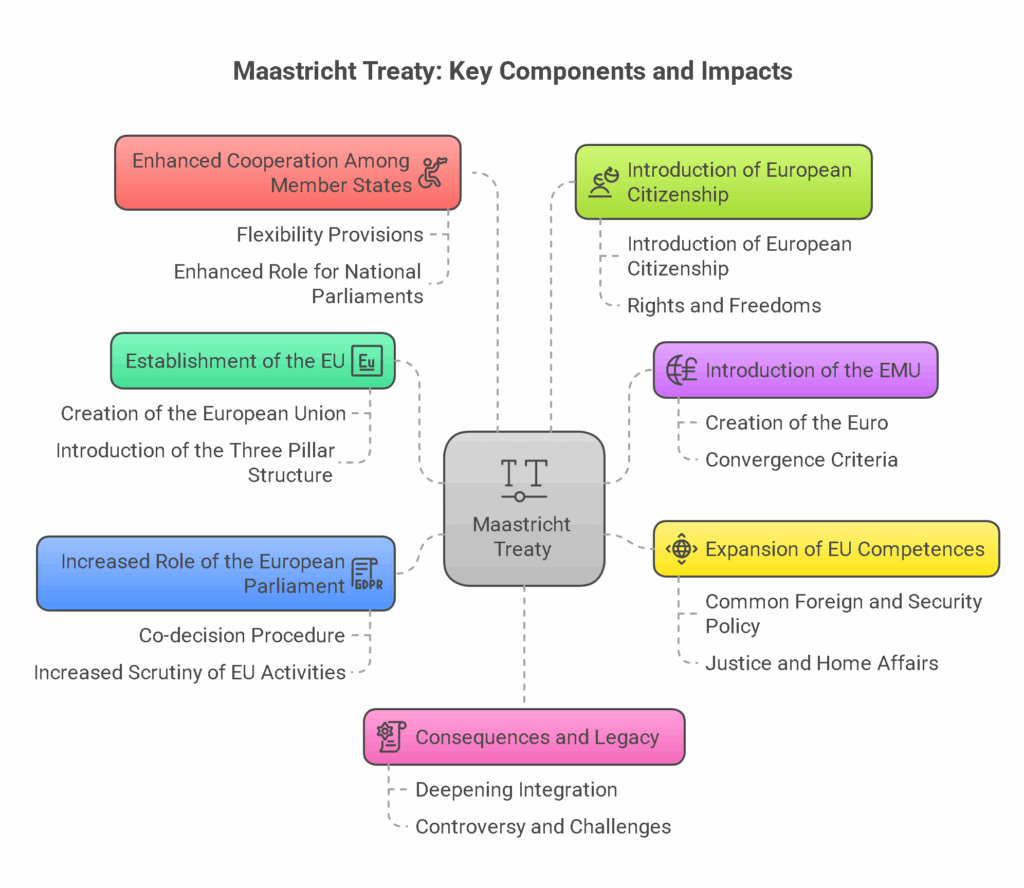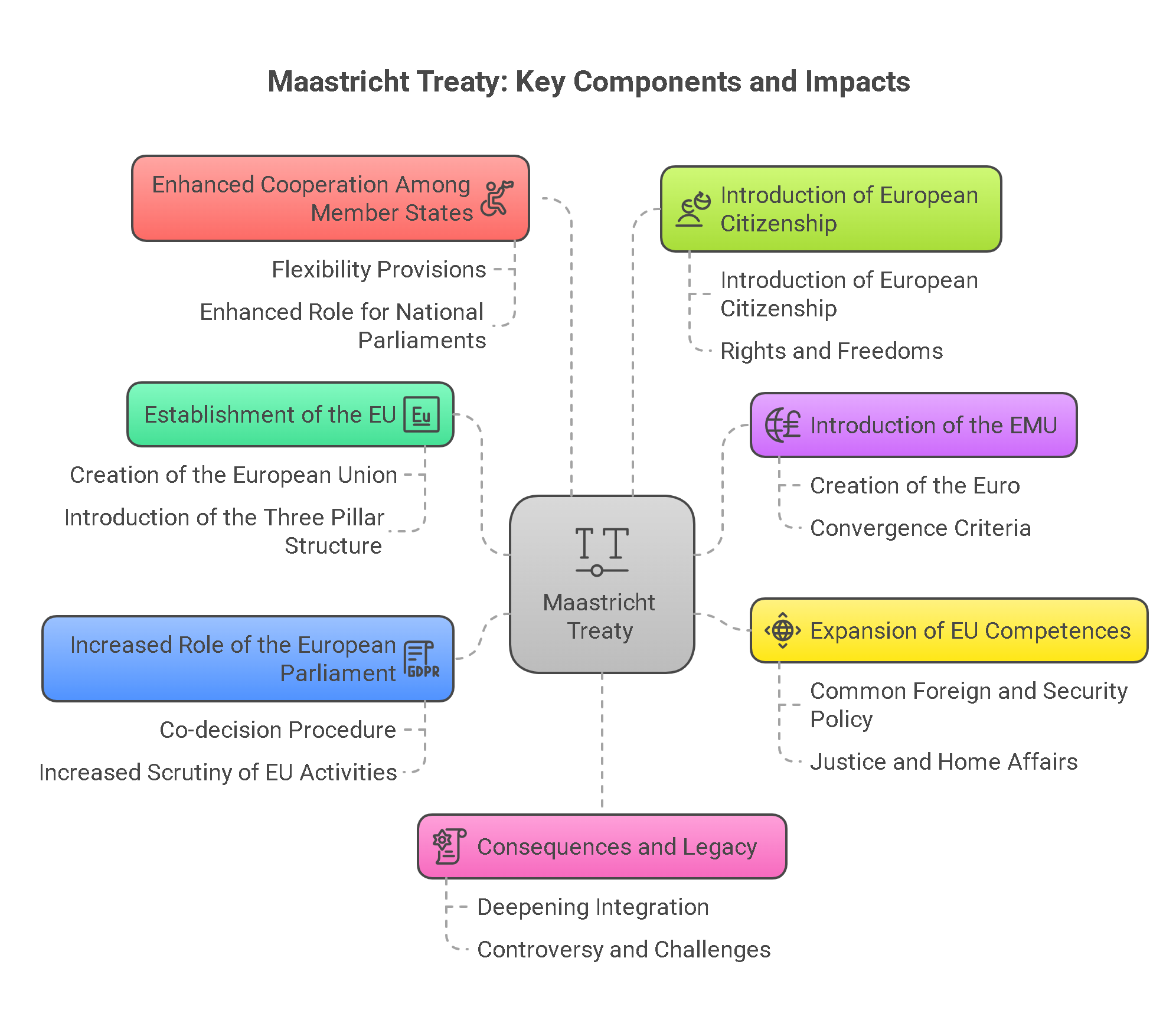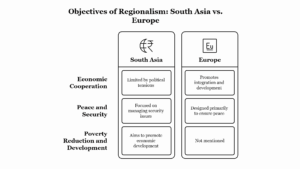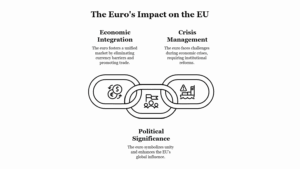The Maastricht Treaty, officially known as the Treaty on European Union (TEU), was signed on November 7, 1991, and came into effect on November 1, 1993. It marked a pivotal moment in the process of European integration, laying the foundation for the modern European Union. The treaty not only introduced significant institutional changes but also broadened the scope of European cooperation, setting the stage for the creation of the Economic and Monetary Union (EMU) and the Common Foreign and Security Policy (CFSP), among other innovations.
Below, we examine the key provisions and significance of the Maastricht Treaty:
I. Establishment of the European Union (EU)
- Creation of the European Union:
- The Maastricht Treaty formally established the European Union (EU), building on the foundations of the earlier European Communities (European Economic Community, European Atomic Energy Community, and European Coal and Steel Community).
- The treaty signified a deeper level of political and economic integration among member states. It formalized the move from a primarily economic community to a broader political union with shared policies and goals, which included not only economic cooperation but also foreign policy, security, and justice matters.
- Introduction of the Three Pillar Structure:
- The treaty introduced a new three-pillar structure for the EU, which consisted of:
- First Pillar: The European Communities (EC), which included the European Economic Community (EEC), the European Atomic Energy Community (EURATOM), and the European Coal and Steel Community (ECSC). This pillar dealt with economic integration, competition policy, the single market, and other aspects of economic cooperation.
- Second Pillar: The Common Foreign and Security Policy (CFSP), which aimed to enhance the EU’s role in global diplomacy, defense, and security.
- Third Pillar: Justice and Home Affairs (JHA), covering matters such as immigration, asylum policies, police cooperation, and judicial cooperation in criminal matters.
- The treaty introduced a new three-pillar structure for the EU, which consisted of:
II. Introduction of the Economic and Monetary Union (EMU)
- Creation of the Euro:
- One of the most significant outcomes of the Maastricht Treaty was the establishment of the Economic and Monetary Union (EMU), which paved the way for the introduction of the single currency, the euro.
- The treaty set out a roadmap for the adoption of a single European currency by 1999 (for electronic transactions) and 2002 (for banknotes and coins). The creation of the euro was intended to enhance economic integration, reduce exchange rate risks, and increase price transparency across the EU.
- Convergence Criteria:
- To ensure that member states were financially prepared for the single currency, the Maastricht Treaty introduced convergence criteria (also known as the Maastricht criteria), which member states had to meet to join the eurozone.
- These criteria included limits on:
- Inflation rates (should not exceed 1.5% above the average of the three best-performing EU member states),
- Government budget deficits (should not exceed 3% of GDP),
- Government debt (should not exceed 60% of GDP),
- Interest rates (should not exceed 2% above the average of the three best-performing EU countries).
- These criteria aimed to ensure that countries adopting the euro had stable economies and that the single currency would not be destabilized by weaker national economies.
III. Expansion of EU Competences and Powers
- Common Foreign and Security Policy (CFSP):
- The Maastricht Treaty significantly enhanced the EU’s role in international relations through the establishment of the Common Foreign and Security Policy (CFSP). The goal was to give the EU a unified voice on the global stage, promoting peace, stability, and democratic values.
- While the CFSP did not create a common European military force, it allowed for more coordinated diplomatic and security actions, including sanctions, conflict resolution, and humanitarian interventions.
- Justice and Home Affairs (JHA):
- The Maastricht Treaty also expanded EU cooperation in justice and home affairs, focusing on issues such as immigration, asylum policies, and cross-border criminal matters. This pillar laid the foundation for enhanced police and judicial cooperation across member states.
IV. Increased Role of the European Parliament
- Co-decision Procedure:
- The Maastricht Treaty enhanced the legislative powers of the European Parliament through the introduction of the co-decision procedure (now known as the ordinary legislative procedure). This procedure granted the Parliament joint legislative authority with the Council of the European Union in areas such as the single market and other policy areas.
- The co-decision procedure strengthened the role of the European Parliament, which had previously been more of an advisory body. This shift reflected the EU’s growing commitment to democratic legitimacy and accountability.
- Increased Scrutiny of EU Activities:
- The treaty gave the European Parliament greater powers over the European Commission, including the ability to approve or reject the appointment of the Commission President and the members of the Commission. This expanded the Parliament’s role in the oversight of the EU’s executive body.
V. Enhanced Cooperation Among Member States
- Flexibility Provisions:
- The Maastricht Treaty included provisions that allowed for differentiated integration within the EU. Member states could choose the extent of their participation in certain policies, such as the Economic and Monetary Union or the establishment of a common defense policy.
- This flexibility allowed for greater cooperation without forcing all member states to move at the same pace in every policy area.
- Enhanced Role for National Parliaments:
- The Maastricht Treaty aimed to involve national parliaments more directly in the decision-making processes of the EU. It introduced a mechanism for national parliaments to scrutinize EU legislation and ensured that they were more involved in the process of EU integration.
VI. The Maastricht Treaty and European Citizenship
- Introduction of European Citizenship:
- One of the significant innovations of the Maastricht Treaty was the introduction of European citizenship. This new status granted citizens of EU member states the right to reside, work, and move freely across the EU. European citizens were also granted additional rights, such as the ability to vote and stand for election in local and European Parliament elections in any EU member state.
- This provision enhanced the sense of shared identity and solidarity among the people of the EU and reinforced the political dimension of European integration.
VII. Consequences and Legacy of the Maastricht Treaty
- Deepening Integration:
- The Maastricht Treaty marked a milestone in the process of European integration, expanding the EU’s competences beyond the economic realm to include social, political, and security dimensions. It set the EU on the path to becoming a political and economic union rather than just an economic community.
- The treaty was a crucial step toward the development of the European Union as it is known today, and it laid the groundwork for future treaties, including the Treaty of Amsterdam (1997), the Treaty of Nice (2001), and the Lisbon Treaty (2007).
- Controversy and Challenges:
- The Maastricht Treaty was not without controversy. Some member states, such as the United Kingdom, were initially resistant to the treaty, particularly regarding its implications for the single currency and the CFSP. These concerns led to debates and even referenda in some countries, reflecting the complex nature of the process of European integration.

Conclusion
The Maastricht Treaty was a transformative document in the history of European integration. It significantly expanded the scope of cooperation among EU member states, creating the European Union, establishing European citizenship, and laying the foundations for the Economic and Monetary Union and a Common Foreign and Security Policy. Its legacy continues to shape the EU’s institutions and policies today, making it one of the most important milestones in the EU’s development.








Leave a Reply